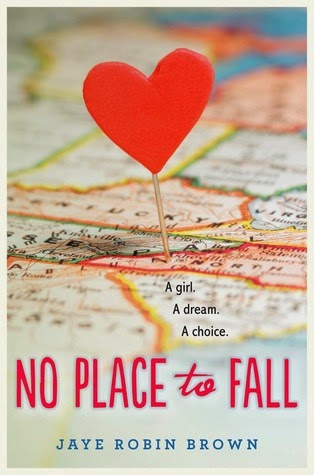If you're writing contemporary, you've got it easy regarding setting, right? No need to research for historical accuracy or imagine and detail a whole new world. Ah-hem. Jaye Robin Brown, author of No Place to Fall, is here today to share with us how we all -- especially those writing contemporary -- can use setting to great effect in our novels. Thank you, Jaye!
Using Setting for Tone in Contemporary YA: A Craft of Writing Post by Jaye Robin Brown
Sometimes I feel a bit like a cheater for writing contemporary young adult fiction. I don’t have to make up elaborate structures of law, or create lands, or mythical animals. There’s no need for mechanical knowledge of space ships or the why’s and how’s of a black hole. It’s just what it is. The here and now.
Writing contemporary comes with its own set of challenges, though. The biggest being that your readers, though they may not know the setting exactly, will know the rules of the land. So what are some of the tricks to sink them so deeply into your story they forget to look for familiar landmarks? There are many—your characterization, a zipping good plot, a smoking love interest—but perhaps the quietest and most subtle of the tools available is your setting.
 |
| cmctecosystems.wikispaces.com |
Here’s a trick. Take a really generic setting. Let’s say, your neighborhood grocery story. Now take a few different genres, contemporary romance, contemporary suspense, contemporary horror. What would be the things in each setting you would choose to write about? What would your MC notice?
For example, in a contemporary romance, maybe she’s picking up two oranges at chest level when her love interest walks by (there’s a meet cute of awkward!). Or she sees an elderly couple giving each other a sweet peck on the lips, the love light still in their eyes. It’s sunny outside, the light is good in the store, and everything is clean, glistening, and smells great (the bakery!).
 |
| from lobshots.com |
In short, your setting shouldn’t be a Barbie house to set your characters inside of and move them around and make them talk and interact. Your setting should be as dynamic and alive as all the other hard won parts of your novel. Each setting, each change of scenery, you have an opportunity for carefully thought out details. Why choose something random when you can choose something to enhance and highlight the tone and mood of your story or scene?
So next revision pass, focus on your setting. Are there places you can draw the mood out more? Objects or background moments that can serve as symbolism or metaphor for your main character? Setting is a gold mine of opportunity to take your story even deeper, especially if you write contemporary fiction.
About the Author:
Jaye Robin Brown, or Jro to her friends and family, lives in the mountains outside of Asheville, North Carolina. A dreamer by nature, she knew life wouldn't be complete until she was surrounded by land, horses, dogs, and one cantankerous goat. When not writing or playing on her fourteen acre farm, you can find her in the art room at the public high school where she teaches.
Website | Twitter | Goodreads | Facebook | Instagram
About the Book:
The Sky Is Everywhere meets This Lullaby in No Place to Fall (HarperTeen), Jaye Robin Brown's poignant debut novel about family, friendships, and first romance. As good girl Amber prepares for her audition at the North Carolina School of the Arts, her relationship with her best friend’s older brother gets more and more complicated. When the bottom drops out of her family’s world in an afternoon, Amber faces an impossible choice, being there for her family, or following her dream as an artist.
Amazon | Indiebound | Goodreads
-- posted by Susan Sipal, @HP4Writers



%2Bprofile%2Bsize%2B(1).jpg)
